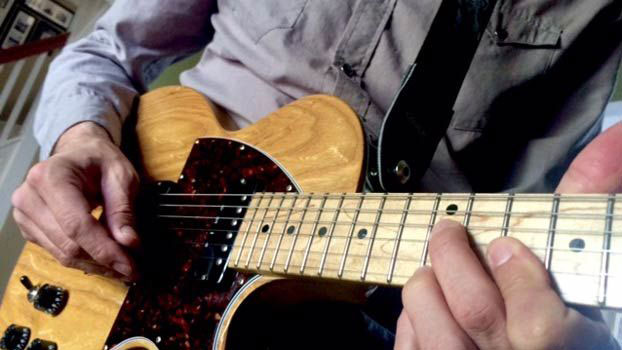Expand Your Melodic Colors with 9th Arpeggios
Add a bit of harmonic color to your ideas with 9th arpeggios.

When learning how to play jazz guitar, many of us know it is important to use arpeggios to outline chords in our licks, phrases, melody lines and solos. While we know learning arpeggios is important, we often can become bored with our playing if we stick to only using root-position, R-3-5-7 arpeggios to build our licks and melodies.
A great way to keep that solid, chord outline in your lines that arpeggios provide, while adding a bit of harmonic color to your ideas, is to learn five-note, 9th Arpeggios. By adding the 9th to the 1-octave arpeggios you already know, you won’t have to start from scratch when learning these five-note shapes, and the 9th will bring a welcomed color tone to your arpeggio-based soloing ideas. In today’s lesson, we’ll be exploring two common fingerings for 9th Arpeggios applied to a ii v I chord progression, as well as explore a classic lick in this style and check out ways to practice these ideas further in the woodshed.
9th Chord Arpeggios 1 To begin, let’s take a look at a ii V I chord progression using 9th arpeggios over each chord in the phrase. As you play through each arpeggio, notice that you may already be familiar with the first four notes of each shape, and then the 9th is just stacked on top of each 1-octave, R-3-5-7 arpeggio that you may already know.
This is the best way to think about 9th Arpeggios, that they are simply a 1-octave arpeggio with one added note at the end of the shape. This will allow you to take any one-octave arpeggio you already know, add one note to the end, and you will have a five-note, 9th arpeggio already under your fingers, rather than learning new fingerings for these shapes from scratch.
Once you have worked on the fingerings below, put on a ii V I backing track in C major and practice improvising over these chords while using each 9th Arpeggios as the basis for your lines. From there, try soloing over ii V I’s in other keys, at various tempos and then apply these 9th Arpeggio shapes to ii V I’s within tunes that you know or are working on in your practice routine.
9th Chord Arpeggios 2 When learning these, or any, arpeggios, it is always a good idea to work out fingerings for them in a number of areas on the neck. This will allow you to always have these shapes under your fingers no matter where you are on the guitar, or what key you are playing in at the time.
Here are the same 9th arpeggios from the previous example but starting with the Dm9 root on the 5th string, and sticking to that general area for the next two shapes. After you have worked out these fingerings, try taking them to other octaves and areas of the neck in order to get a full grasp of how these shapes lie in each area of the guitar.
All the latest guitar news, interviews, lessons, reviews, deals and more, direct to your inbox!
9th Chord Arpeggios Lick To finish this introduction to 9th Arpeggios for guitar, here's a ii V I lick that uses 9th arpeggios as the basis for each chordal outline. In order to spice things up a bit, I’ve added a lower-approach note to the root-note in the first bar.
If you want to explore this concept further, you can check out my GuitarWorld.com column “Three Easy Steps to Creating Killer Arpeggio Licks.” After learning this lick in the key below, C major, practice it in other keys, all 12 if possible, at different tempos and then apply it to your solos over different tunes you are working on in the practice room.
When you are comfortable with this lick, build your own soloing ideas, either writing them out or on the spot, that use 9th Arpeggios as the melodic basis for your phrases and licks.


Adding one extra note to your root-based arpeggios is a great way to add color to your lines, while still outlining the underlying chord changes in a very real and interesting fashion. Check out these fingerings in the woodshed this week. Then, try bringing them to other chords you know, other keys, chord progressions and to full tunes that you are working on in your jazz guitar practice routine.
Matt Warnock is the owner of mattwarnockguitar.com, a free website that provides hundreds of lessons and resources designed to help guitarists of all experience levels meet their practice and performance goals. Matt lives in the UK, where he is a senior lecturer at the Leeds College of Music and an examiner for the London College of Music (Registry of Guitar Tutors).

Matt Warnock is the owner of mattwarnockguitar.com, a free website that provides hundreds of lessons and resources designed to help guitarists of all experience levels meet their practice and performance goals. Matt lives in the UK, where he teaches Skype guitar students all over the world, and is an examiner for the London College of Music (Registry of Guitar Tutors).
